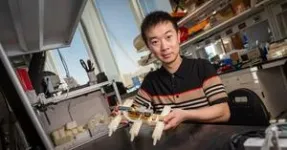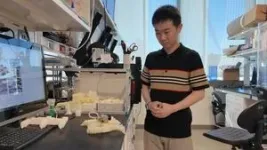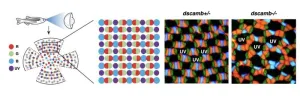Obesity is linked to numerous health complications, including diabetes, cardiovascular disease, and fatty liver disease. In a world where obesity rates continue to climb, researchers are constantly seeking effective, accessible solutions to this global health crisis. Interestingly, over the past few decades, scientists have begun to focus not only on what we eat but also on how we eat it.
While much attention has indeed focused on dietary content and caloric intake, emerging research suggests that eating behaviors—including meal duration, chewing speed, and number of bites taken—may have a big impact on how much food we consume. Previous studies have indicated that people who eat more slowly tend to consume less food overall, but specific, evidence-based guidelines on how to effectively slow down eating have been lacking. This is particularly true for Japan, where eating habits differ from Western norms.
Against this backdrop, a research team led by Professor Katsumi Iizuka from the Department of Clinical Nutrition, Fujita Health University, Japan, conducted a study to identify factors that influence meal duration and eating behavior. Their paper, co-authored by Dr. Megumi Aoshima and Dr. Kanako Deguchi from Fujita Health University and published in Volume 17, Issue 6 of Nutrients journal on March 10, 2025, explores factors including sex differences, chewing patterns, and external rhythmic stimuli and their relationship to how we consume our meals. “While nutritional science is often concerned with food metabolism and absorption and dietary content, there’s limited evidence in Japan on dietary behavior that connects the two. This intrigued me to study eating behavior, which involves gender differences,” explains Iizuka.
The study involved 33 healthy participants aged 20 to 65 years who were asked to eat slices of pizza under different conditions. Researchers measured meal duration, number of chews, number of bites, and chewing tempo (the rate or speed of chewing), noting how these variables changed when participants were exposed to different metronome rhythms using headphones.
The results revealed significant differences between men and women in eating behaviors. Women typically took longer to eat, averaging 87 seconds compared to 63 seconds for men. They also chewed more (averages of 107 vs. 80) and took more bites (4.5 vs. 2.1). However, the actual chewing tempo was similar between both sexes.
When adjusted for sex differences, meal duration was positively associated with the number of chews and bites taken, but not with body mass index or average eating tempo. Perhaps most interestingly, when participants were exposed to a slow metronome rhythm of about 40 beats per minute, their meal duration increased significantly compared to eating without rhythmic stimulation.
The study suggests several straightforward strategies to extend meal duration: increasing the number of chews per bite, taking smaller bites (which naturally increases the total number of bites per meal), and potentially creating a slower eating environment through calming music or rhythmic cues. “These are easy, money-saving measures that can be started right away to help prevent obesity,” says Iizuka, highlighting the practical implications of the results.
These findings have particular relevance for nutritional guidance and obesity prevention programs. Rather than focusing solely on food content, interventions could incorporate guidance on eating behaviors and environmental factors that promote slower eating. “Incorporating the proposed eating behavior into school lunches and other programs can lead to the prevention of future diseases related to obesity,” Iizuka notes.
The researchers acknowledge that future studies should test these findings with a variety of foods beyond pizza to confirm their applicability in diverse eating scenarios. Nevertheless, this research provides valuable evidence-based strategies that could be incorporated into obesity prevention and treatment programs immediately, without significant cost or complexity.
Hopefully, these efforts will help spread actionable advice to both prevent and address obesity and minimize its impact on health down the line.
***
Reference
DOI: 10.3390/nu17060962
About Fujita Health University
Fujita Health University is a private university situated in Toyoake, Aichi, Japan. It was founded in 1964 and houses one of the largest teaching university hospitals in Japan in terms of the number of beds. With over 900 faculty members, the university is committed to providing various academic opportunities to students internationally. Fujita Health University has been ranked eighth among all universities and second among all private universities in Japan in the 2020 Times Higher Education (THE) World University Rankings. THE University Impact Rankings 2019 visualized university initiatives for sustainable development goals (SDGs). For the “good health and well-being” SDG, Fujita Health University was ranked second among all universities and number one among private universities in Japan. The university became the first Japanese university to host the “THE Asia Universities Summit” in June 2021. The university’s founding philosophy is “Our creativity for the people (DOKUSOU-ICHIRI),” which reflects the belief that, as with the university’s alumni and alumnae, current students also unlock their future by leveraging their creativity.
Website: https://www.fujita-hu.ac.jp/en/index.html
About Professor Katsumi Iizuka from Fujita Health University
Dr. Katsumi Iizuka serves as a full Professor at the Department of Clinical Nutrition of Fujita Health University, Japan. He conducts research on nutritional therapies that contribute to preventing and reducing the severity of overnutrition and undernutrition, as well as their implications in nutrition-related diseases such as metabolic disorders. He has published well over 80 research papers on these topics.
Funding information
This research received Suzuken Memorial foundation (23-003).
END







